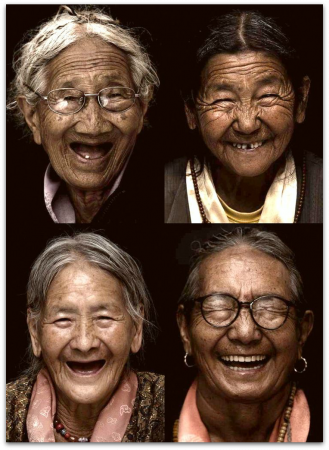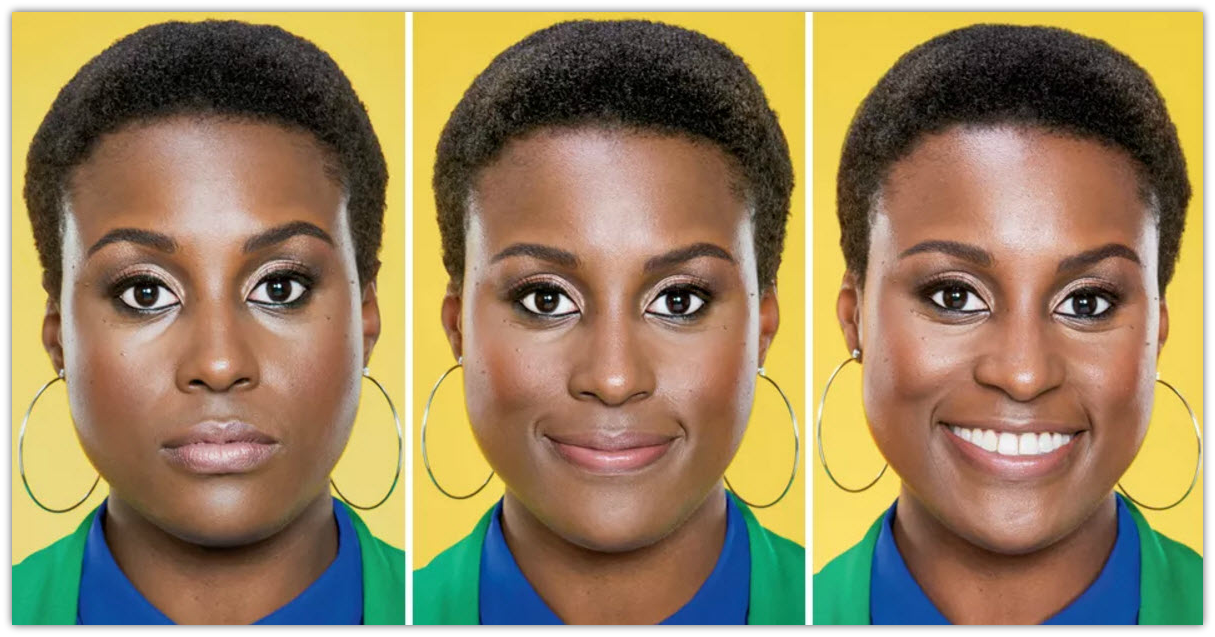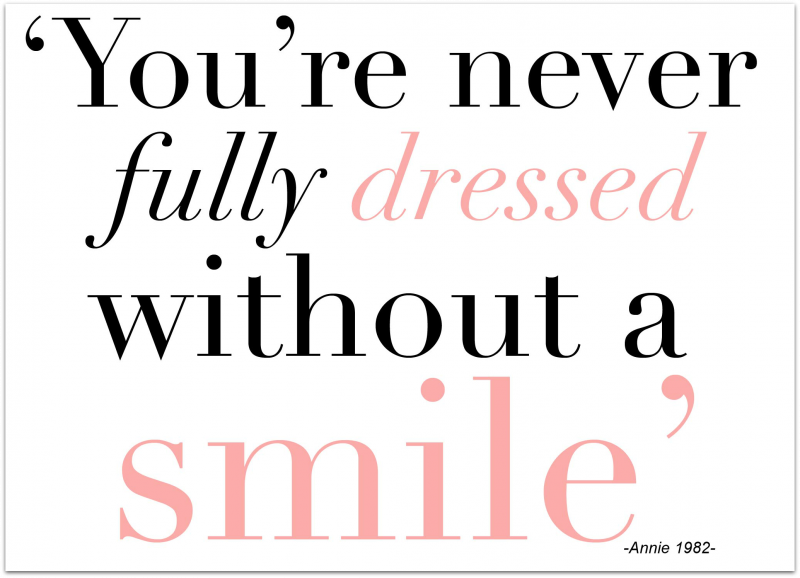
When was the last time you smiled at someone and what reaction did you get? I smile back, I’ll wager.
It’s all too easy to forget about how our body language and facial expressions are affecting our image and relationships when we’re so conditioned to think mainly about our clothes and grooming. In the same way that makeup and style contribute to how we feel about ourselves and how others perceive us, our body language and facial expressions are just as important.
A smile is the most effective tool we own when it comes to connecting with others. It’s a silent language that everyone understands and it’s an invaluable companion when making and cementing relationships.
So let’s take a minute to examine what makes a smile appear genuine.
What is a Good Smile?
Look at the smiles in the lineup below, which ones do you think are genuine? (Answers at the base of the feature)
A genuine smile is one that is authentic and comes from the heart and envelopes the entire face. Interestingly science has proven that most people can spot a fake/insincere smile and a fake smile is rarely reacted to in a positive way.
There are three main elements to a genuine smile:
- raised corners of the mouth
- slight wrinkle/crow’s feet around the eyes due to the raising of the cheeks
- eyes that connect and radiate warmth
A fake smile only raises the corners of the mouth because we cannot voluntarily contract the muscles around our eyes. Real smiles communicate sincerity and warmth and shows other people that you are present, engaged, and involved, whether it be a social or business situation.
How to Smile
- A genuine smile is not confined to the face but is echoed throughout the body with open gestures and postures. So don’t cross your arms across your chest or have your hands on your hips when smiling.
- Make eye contact when smiling. This is especially important when meeting someone for the first time. Eye contact plus a smile is the easiest way to make a good first impression.
- While you’re smiling, be completely engaged in the moment. If you’re removed from the interaction, your smile will appear fake. Think positive thoughts and be engaged, this will definitely reflect in your smile.
- Show your teeth. A genuine smile parts the lips as the face muscles contract. A close mouth smile is one where the person smiles because they know they should rather than they want to or is given by someone who is embarrassed about their teeth. If you’re the later case you owe it to yourself to invest in your smile and have your teeth fixed.
- Never tell a person to smile. It will only make you appear condescending. Let your smile be contagious, and let your smile encourage more smiles. Non-verbal cues are stronger motivations to reciprocating or giving out smiles.
- Practice makes perfect! Practicing your smile in front of your mirror may seem cheesy, but it will pay off. You will know when your smile is real cause you will feel the difference, even if it’s just you and the mirror.
When to Smile
Here are some scenarios when smiling will prove most effective:
- When being introduced to or greeting someone – it’s a good way to be remembered.
- When you agree with someone or something. This shows your engagement and agreement.
- While shaking hands, it’s both professional and memorable. When you do this in a business setting, it’s been proven that the other party will listen to you more attentively and take what you say more seriously.
- When you’re on the phone. Yes, the person on the other line won’t be able to see your smile but it has been proven that they can hear it. The physical act of smiling has been proven to add sincerity and warmth to your voice.
- When disagreeing, debating, or having an argument with another person, setting forth your points with a smile make the exchange less heated. A smile will communicate your openness in hearing out someones opposing views and will be seen as a sign of mutual respect.
- When you say a person’s name. This will give you both a positive vibe about past, present, and even future encounters.
- When you say goodbye to someone. A smile will make them look forward to getting to spend time or see you again.
- During a job interview. In between imparting your answers, smiling is a good way to let your prospective employers know that you have a pleasant disposition.
- When you’re feeling down. The mere act of smiling, even just to yourself, can uplift your day. Smiling to yourself in the mirror or smiling to people on the street are both instant mood booster. Who knows the smile you give may be brightening someone’s day?
- All the time, to everybody. Like a stare, or staying sorry too often, a constant smile on your face can make you appear in-genuine, submissive or evoke suspicion. It can also send someone the wrong message about whether or not to take you seriously. Besides, if you’re constantly smiling, you also have nowhere to go when you genuinely want to express pleasure or gratitude.
- When it’s inappropriate for the occasion.
- When you want to project authority. Some experts say that women undermine our power in the workplace by smiling too much. And indeed, in our culture, excessive smiling is the mark of a subordinate, especially if the person in front of us is not smiling at us.There’s some fascinating research that shows people in positions of power will return the smile of a subordinate, but are slower to smile at someone of equal status. Keep that in mind next time you’re in a difficult negotiation, especially if you want to be seen as an equal.
Health and Social Benefits
There are multiple health and social benefits to smiling. Countless studies have  been done to look into these said benefits. Studies have found that smiling offers the following health benefits:
been done to look into these said benefits. Studies have found that smiling offers the following health benefits:
- Lowers blood pressure
- Releases endorphins, known as the feel-good hormone
- Relieves stress
- Boosts immune system
- Boosts mood
A smile is a physical act that has real and measurable benefits to our psychology and physiology alike.
As soon as your mouth breaks into a smile, it can change your brain by releasing endorphins and serotonins. When you smile, it doesn’t just make you feel good it makes other and those around you feel good as well. Spreading smiles is a healthy thing that holds benefits for all. Smiling is indeed a free and easy form of everyday quick therapy. Smiles encompass both the body, the mind, the heart, and the soul.
So, there you have it; the social benefits of smiling are endless. The mere act of smiling already shows the world that you are ready to engage. Smiles express that you are responsive and receptive. It’s an invitation to converse, and a non-verbal cue that says you are amenable to social interaction. This positivity opens you up to more experiences and interactions, and in turn, it is proven to improve relationships with others and yourself.
Remember
Answer: Genuine smiles are image C and D
If you enjoyed this week’s feature
please like it on Facebook or Instagram
or leave a comment/question below.
Thank you.
Ann Reinten AICI CIP
Author





Makes me want to smile…
Thanks Clare!